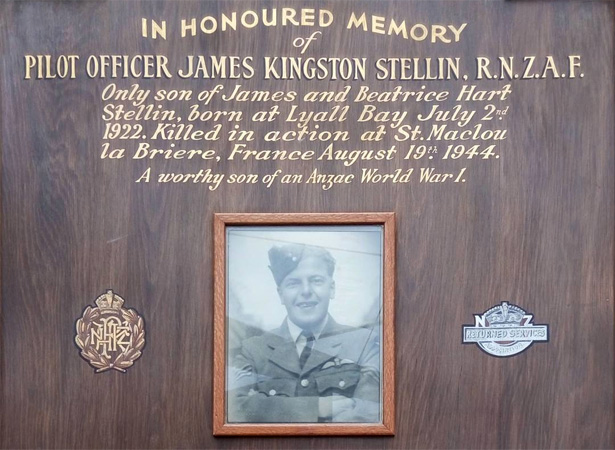
As his damaged Hawker Typhoon fighter-bomber rapidly lost height, Pilot Officer James Stellin struggled to avoid crashing into Saint-Maclou-la-Brière, a village of 370 people between Le Havre and Dieppe in northern France. He succeeded, but at the cost of his own life. The villagers gave him a hero’s funeral and have honoured his memory ever since.
James Kingston (‘Joe’) Stellin was one of several thousand New Zealanders who flew with the Royal Air Force over Europe in support of the D-Day landings in 1944. Born in Wellington on 2 July 1922, he was the son of James and Beatrice Stellin of Lyall Bay. He attended Scots College before enlisting in the Royal New Zealand Air Force in 1942 and beginning pilot training. On 3 June 1944, three days before D-Day, he and two other Kiwi pilots were posted to 609 Squadron, RAF, at Thorney Island airfield in West Sussex. Over the following month, 609’s pilots flew numerous missions over Normandy, targeting German radar stations, tanks and other vehicles. In early July the squadron moved its base to France, arriving at Plumetot, north of Caen, under shellfire and in mud and rain. For the next six weeks Stellin flew almost daily missions against German tank concentrations, strongpoints and motor transport in the Falaise area.
On 18 August, 609 Squadron’s Typhoons destroyed at least seven German tanks and 12 vehicles. Stellin flew again that evening, attacking vehicles on the Vimoutiers–Orbec road and setting five alight. On the 19th, 609 Squadron again targeted German transport trying to escape the Falaise pocket. At 8.30 a.m. Stellin took off from Martragny airfield, flying Typhoon JP975. After destroying several tanks and trucks, Stellin’s aircraft was heading home when he asked permission to descend to attack a vehicle. He did not return to his formation and asked for a homing to find his way back to base. He was given a course but later reported that he was short of fuel. It is thought that his plane was hit by flak near Bernay. A teacher at Saint-Maclou-la-Brière, Monsieur Jacobs, described the scene:
It was 10 o’clock in the morning when the sounds of an aircraft in difficulties first made us look up. The plane was about 1500 to 2000 feet up, and rapidly losing height. Suddenly, on realising the great destruction his plane would cause if it were to crash in the centre of the village, the pilot straightened up his plane with a vigorous and supreme effort, made a half-climb, then turning sharp left at an acute angle, it fell rapidly, crashing less than a mile away.
Stellin bailed out at the last moment, but his parachute failed to open and he was killed. He was 22 years old. His funeral in Saint-Maclou-la-Brière was attended by 1200 people from the surrounding area. His grave in the local cemetery was later designated a Commonwealth War Grave; ever since it has been decorated regularly with flowers. In 1946 M. Jacobs, who had been active in the local Resistance, wrote a moving letter to Stellin’s parents. The following year the Kiwi pilot was posthumously awarded the Croix de Guerre avec Palme. The people of Saint-Maclou-la-Brière later engraved Stellin’s name onto the war memorial for the dead of their own village. In 1964 they erected a black marble memorial stone to Stellin outside the gates of their church. In 2001 the area in front of the St Maclou church was named ‘Place Stellin’.
Stellin has also been commemorated in New Zealand. A memorial board was erected in the Kilbirnie RSA and when that building closed it was moved to his old school, Scots College. The College library is named in Stellin’s honour and the school holds other memorabilia. When James’s father, a prominent Wellington businessman and developer (he was responsible for the subdivisions of Avalon, Kingston and Strathmore Park), died in 1964, he bequeathed funds to build the memorial in Saint-Maclou-la-Brière. He also gifted land on the eastern side of Tinakori Hill to the Wellington City Council to create the James Stellin Memorial Park. In August 2007, Wellington Mayor Kerry Prendergast and French Ambassador Michel Legras unveiled a long-promised plaque in the Memorial Park.
We are grateful to John Bickerton for supplying information about James Stellin.
Image: Hawker Typhoon
Download the letter from Monsieur Jacobs about James Stellin (pdf)
Read more on NZHistory
New Zealanders in the air – D-DayJames Stellin memorial in France – D-DayJames Stellin Memorial Park – Memorials registerOverview: 1913-1945 – Royal New Zealand Air ForceRNZAF timeline – Royal New Zealand Air Force
External links
How to cite this page
'Kiwi pilot's sacrifice saves French village', URL: https://nzhistory.govt.nz/page/kiwi-pilots-sacrifice-saves-french-village, (Ministry for Culture and Heritage), updated 12-Aug-2021
